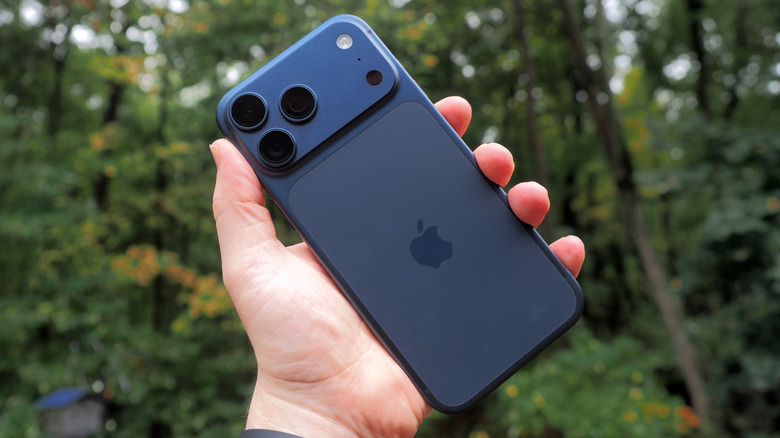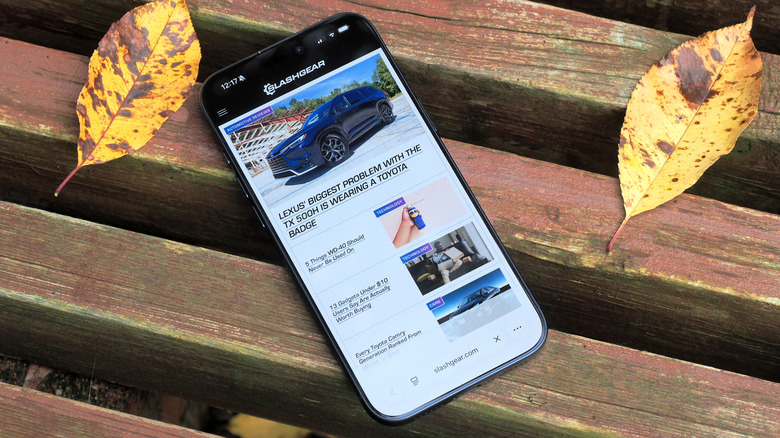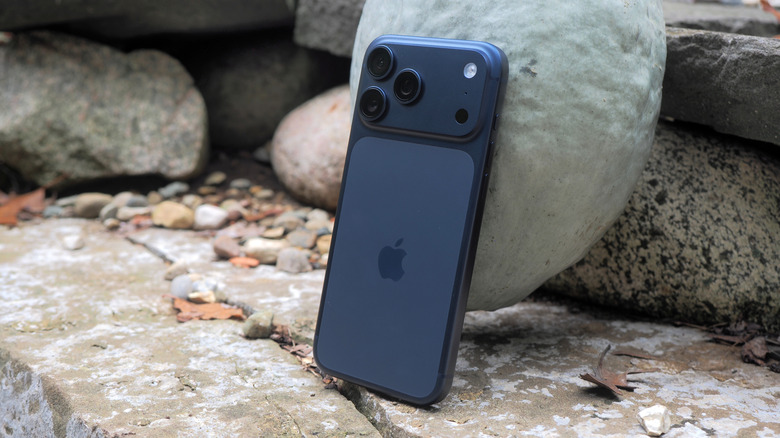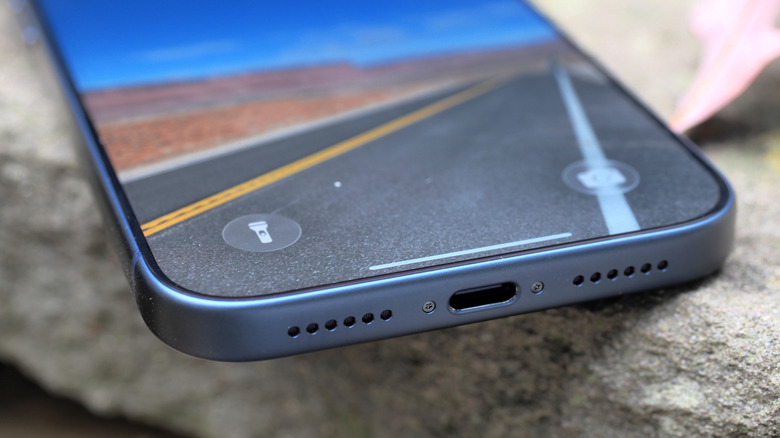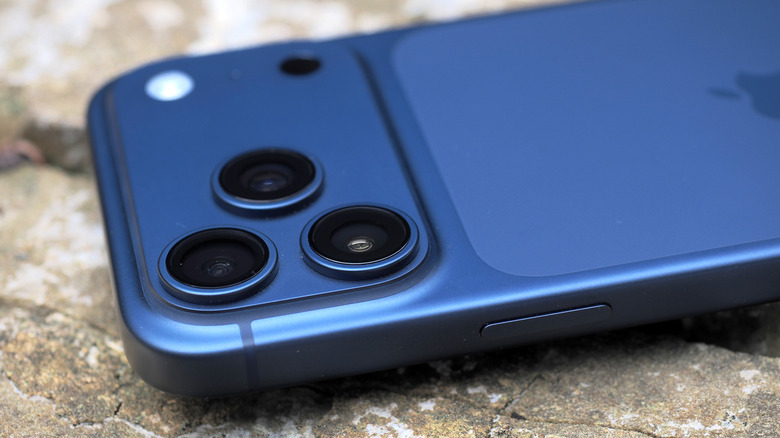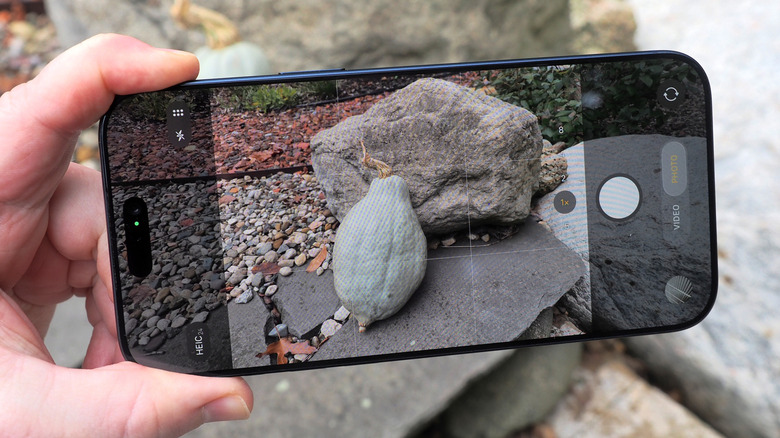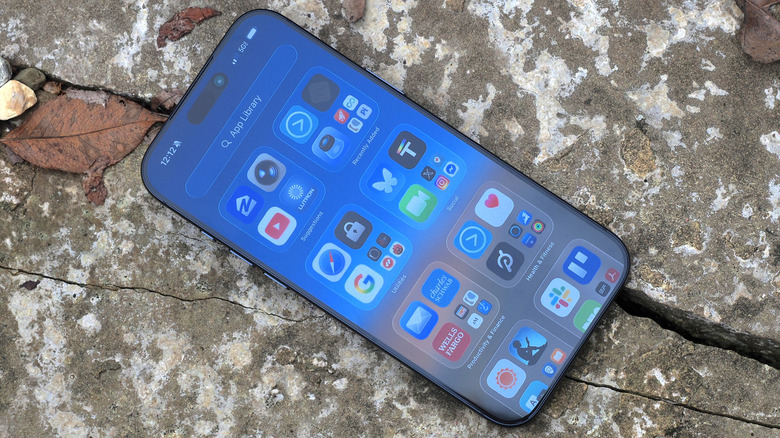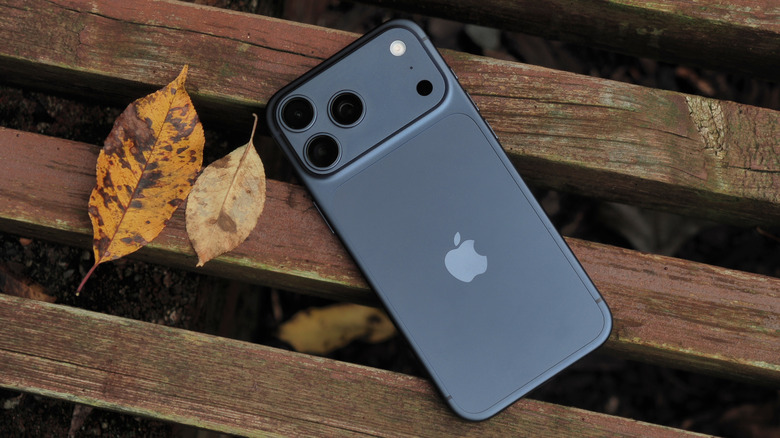It's Expensive, But Apple's iPhone 17 Pro Max Steals The Show
We may receive a commission on purchases made from links.
Apple pulled out all the stops this year to coax the pocket book out of your pocket. There's the debut of a brand new, super-skinny iPhone Air, and a more capable iPhone 17 with display improvements that feel long overdue. Then there's the iPhone 17 Pro and iPhone 17 Pro Max, Apple's workhorse duo which, for 2025, feel more distinct than ever.
For the past few years, iPhone differentiation (visually, at least) has felt like a matter of scale. Sure, the Pro models had an extra camera lens on the back, but it was nestled in the same glass-and-metal sandwich as the lesser models. This time around, though, you can tell at a glance which new iPhone is which.
That also means it's easier to spot the sacrifices. The iPhone Air makes battery and camera compromises by virtue of its slenderness, and the iPhone 17 drops power and lenses to better capture the mass market, but the iPhone 17 Pro (and this iPhone 17 Pro Max, in particular) leaves nothing on the table. Or, to be more accurate, it only makes one real concession; and even then it's yours, not Apple's.
Flagship spec, flagship prices
This is not a cheap phone: $1,099 in its most basic form, with the smaller of the two displays Apple offers, and 256GB of storage. The iPhone 17 Pro Max, with its larger screen, commands a $100 premium. Apple offers 512GB and 1TB versions, as before, but the new 2TB configuration — exclusive to the larger Max — lands at a heady $1,999.
Apple is not alone in asking arguably silly money for a brand-new smartphone. Samsung's Z Galaxy Fold 7 starts at $2K; if you can do without its folding screen, the Galaxy S25 Ultra starts at just over $1.4K. Both companies have put their heft behind healthy trade-in promotions, too, and some U.S. carriers promise as much as $1,100 if you have an older smartphone to swap.
Still, given the current economy, splashing out the equivalent of a decently-spec'd MacBook Pro on a phone could be considered particularly lavish. Especially since, as has been the case with its predecessors in recent years, the "regular" iPhone 17 is so adept.
At least people will know you spent top-dollar
There's greater visual distinction, at least, between the Pro and non-Pro versions. Apple uses a new "forged unibody design" for the iPhone 17 Pro, a skeleton of aluminum offered in anodized Deep Blue, Cosmic Orange, and Silver. It's more durable, the company says, though I'd still recommend one of the handsome new TechWoven cases. Those also work in tandem with a new vapor chamber that basically wicks away chipset heat so that the smartphone can avoid throttling down when things inside get toasty.
You get to see the improvement — or, more accurately, feel it — on day one, when restoring data and apps to a new iPhone can definitely result in some heat. As was the case when I later tested the iPhone 17 Pro Max with some CPU/GPU intensive apps and games; the phone still got noticeably warm, but not uncomfortably so. Neither did the heat from the new A19 Pro chipset feel localized to one ominous point on the rear, as has been the case with the iPhone 16 Pro.
Arguably just as important, though, the new design feels better in your hand. Total weight is up, versus last year, though, at 206 grams for the iPhone 17 Pro and 233 grams for the 17 Pro Max, it's a mere 6-7 gram increase. However, the unibody's softer edges are more comfortable to grip. Apple's integration of the camera bulge into the unibody, which now spans the full width of the iPhone 17 Pro's rear, both gives more real-estate to thread antennas around, as well as makes it obvious to those around you that you sprang for the pricier phone. It avoids desk wobbles, too.
Big screen, big battery life
On the flip side, the absence of a "Plus" model for the regular iPhone 17 means this iPhone 17 Pro Max is the only option if you want Apple's biggest display. The 6.9-inch ProMotion OLED panel still supports a 120Hz refresh rate, always-on mode (which is great when you have the iPhone sat upright on a MagSafe desk stand), and outdoor brightness is now up to 3,000 nits. They're all features shared by the smaller iPhone 17 Pro's 6.3-inch screen.
Thing is, the iPhone 17's 6.3-inch screen also supports 120Hz ProMotion, as does the iPhone Air's 6.5-inch display, and both have the same outdoor brightness rating. Don't get me wrong, Apple's Pro panel here is more than easy on the eyes, but you no longer need to opt for the most expensive iPhone to get it. The cynic in me wonders if that's what explains the absence of an iPhone 17 Plus this year.
Being the physically largest model does give the iPhone 17 Pro Max a battery advantage, mind. Apple quotes runtime improvements for both Pro versions, but it was the impact of the Max's physically larger battery I was most curious about. A combination of that, plus software efficiencies and other power management (which hasn't had a noticeable impact on actual day-to-day use), means I've ended the day with more remaining battery than on any previous iPhone.
All the cameras
2025's cameras are an evolution of last year's rig, with 48-megapixel Fusion sensors across the board for the rear. Most default to a 24MP HEIC shot in your camera roll, as like before, hardware and software are interwoven inescapably and can impact that. The Fusion Telephoto, for example, now promises 4x zoom (100mm equivalent, down from the 5x/120mm of last year's Pro) or 8x optical-quality (200mm equivalent), courtesy of a physically larger sensor and improved stabilization; but while the former can be saved at up to 48MP, the latter tops out at 12MP.
Apple likes to talk pipelines when it comes to its cameras — basically the summation of the sensors and lenses, and the various processing applied to what they capture. There's a 2x optical-quality zoom on the main camera, for instance, just like before, but Apple says pipeline improvements mean more pleasing color and more detail. Similarly, wide-angle shots promise greater detail and accuracy, while there's a next-gen Portrait mode (also supported on other new iPhones of this generation) with automatic depth capture, assuming your subject is a person, a dog, or a cat.
With iOS 26's redesigned Camera app simplifying the controls, though, much of the complexity happens behind the scenes. I also found the Camera Control button on the side to be smoother to use for adjusting zoom or focal length. Third-party apps like Halide can still surface more options for those who prefer to dig in.
More natural looking photos
I was impressed by the photographic talents of 2024's iPhone 16 Pro, and I'm similarly impressed by what this year's phones deliver. As always, the improvements in the final shot are fairly granular; there's more of an impact in framing from things like the higher-quality telephoto lens. I use the zoom a lot, and so changes there are more welcome than, say, the iPhone 17's upgrades to its ultra-wide camera.
Photos themselves take a welcome half-step back from the exaggeration that modern phones assume we prefer. Out of the box, colors are realistic rather than leaning saturated. Apple's HDR doesn't go overboard and drag darker sections of the frame into artificial-looking brightness. Certainly you can tweak that, either by adjusting the defaults, or tapping into the various color styles. But I enjoyed the emphasis on detail and reflecting what my eyes actually saw.
That said, there are times when the processing can still be heavy-handed. My go-to test is how well Portrait mode handles fine detail like pet fur and whiskers (look, I take a lot of cat photos, okay?), and there's still a tendency here to opt for a sharp line between subject and background where softness would look more natural. Whiskers get erased, and errant hairs get smoothed out.
The result is crisp, certainly, but at the expense of feeling realistic. You can adjust the effective focal length — and thus the background blur — later on, or indeed turn Portrait mode off altogether, to finesse the results, or simply rely on the natural bokeh from the telephoto lens. I think it looks much better, though you do of course need sufficient distance from the subject.
Friend-friendly selfies
Flip the iPhone 17 Pro over, and the new Center Stage front camera encourages friendliness. Its new square sensor means you no longer need to flip the phone horizontally to get the widest field of view: the Camera app simply reframes automatically as it spots more people entering (or exiting) the scene. You can also override that manually. It's arguably a small thing, but for a not-insubstantial phone like the iPhone 17 Pro Max, being able to maintain a portrait-aspect grip could help avoid testing out Apple's claimed toughness improvements on the Ceramic Shield 2 front glass.
Video capture changes are a two-tier affair. For most, the better stabilization during capture will be the noticeable benefit: that feature works across all sensors, front and rear, ousting shake without looking artificial. I don't think my cat appreciated me chasing her around the house with the iPhone held at tail-level, but the resulting footage held most of my stomping movements at bay. As before, there's an Action mode which wields even greater processing for increased smoothing, but it complains in lower-light situations.
Joining Dolby Vision 4K 120fps capture, meanwhile, are ProRes RAW and genlock support. Honestly, if those are not familiar terms, then you're probably not the pro-videographer audience these features are intended for: Think more raw sensor data and more accurate frame sync, great if you're swapping traditional video cameras for an iPhone 17 Pro (or, maybe more likely, integrating Apple's phone into such a setup with existing cameras). You'll need to be using specific camera apps — and the Blackmagic Camera ProDock ($300) for genlock — to tap into these new talents, initially. Although, Apple says its APIs are available for others to integrate with, too.
iOS 26 leans on Liquid Glass
Arriving alongside the iPhone 17 family is iOS 26, though of course, owners of existing handsets back to the iPhone 11 and iPhone SE (2nd gen) can have it as a free upgrade. You'll notice the translucence of the new Liquid Glass theme first, with greater customization over how icons and widgets look, but there are plenty of less obvious tweaks and changes. Some require a little retraining of muscle memory, though generally for the better: Search fields are now typically located closer to the keyboard, for instance, rather than demanding a stretch to the top of the screen.
Apple Intelligence remains, too (and remains optional to enable), though in contrast with the "AI, everywhere" marketing strategy of Google, Samsung, and others, Apple seems a tad more subtle about its place on the new iPhone. Since I continue to believe myself more than up to the challenge of replying to emails without needing AI to make my tone perkier or more businesslike (and to be sufficiently capable of summarizing text chains on my own), I'm not particularly unhappy about that strategy.
Genmoji and apps like Image Playground still feel gimmicky to me, but AI's potential for things like live translation could well be game-changers. That currently works in phone and FaceTime calls, as well as Messages chats. Pair it with a recent set of AirPods, like the new AirPods Pro 3, and you can have the real-time translation piped surreptitiously into your ears. It's a reminder that AI comes in different flavors, and while generative AI may come in for (often justified) criticism, that's not to say everything now lumped under the "Artificial Intelligence" umbrella is so problematic.
iPhone 17 Pro verdict
A good chunk of iPhone 17 Pro owners won't necessarily stretch the limits of its processing power, or its video capture tech. I suspect the same could be said for last year's phone, and Apple's flagship from the year before that. Nonetheless, improvements in the iPhone 17, along with the arrival of the iPhone Air, make it easier to list the reasons you might want to go Pro this time.
It has the best battery life, the most powerful chipset, and, in the iPhone 17 Pro Max, the biggest screen. It has more cameras and an ever-useful longer telephoto lens; LIDAR where the others go without; and a much faster USB-C port (USB 3 for up to 10 Gb/s, versus the others' 480 MB/s USB 2) with support for video capture to an external SSD.
I'd say the iPhone 17 Pro Max gets the biggest bang for your buck on display and battery life. Meanwhile, those with an iPhone 15 Pro or 16 Pro can probably afford to hold out another year, and there's a strong argument that the iPhone 17 is the best all-rounder for most people.
Here's the thing: To me, being "Pro" is about having options. The most flexible array of cameras at hand, an expansive screen, a chipset powerful enough that sluggishness isn't an issue today, and more demanding software updates aren't a headache tomorrow. While the waif-like iPhone Air is fascinating, and the lower price of the iPhone 17 is appealing, I know each makes sacrifices on camera, power, or battery that'll frustrate me over time. As always, the decision comes down to you actually being a genuine "Pro" user and, if so, whether that's the same sort of "Pro" that Apple had in mind.
